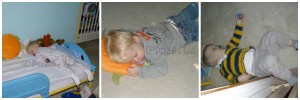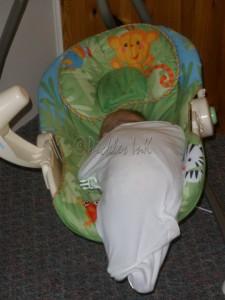When it comes to Team Pickles, babies, and sleep, our luck has been pretty even.

Molly asleep in her crib (in a manner of speaking). Caption reads: “Let Sleeping Babies Lie no matter how uncomfortable they may look!”
Actually, when it comes to EVERYTHING, our luck is pretty even. My friend Catherine once said of Ian and I that we have the most luck of anyone she’s ever met. The problem is that on any given day we have no idea if it’s going to be GOOD luck or BAD luck. One day we’re winning a top-of-the-line trampoline because of a tongue-in-cheek Facebook post and the next we’re burning down our apartment 6 days after our wedding (true story – I’ll post about that some other time).
But I digress.
Ben was an easy sleeper pretty much from day one. Like any newborn, he woke in the night to eat, but by about 4 months he was easily sleeping through. To make things even simpler, he would sleep anywhere and everywhere – in the car…in the stroller…in his highchair…in the middle of the floor if that was where he happened to be when he got tired, and he slept so soundly that I used to clip his nails while he napped.

Case(s) in Point: 3 of the many “Ben sleeping in random positions” pictures
When he was a toddler, his afternoon routine was lunch followed by a bottle in his highchair, after which he would immediately fall asleep and I would recline the highchair, turn off the kitchen light, and go down to the basement to work for a few hours while he napped.
Bedtime was just as easy – if we were the slightest bit late starting his bedtime routine, Ben would bring us a bottle, grab our hands and beg, “Bed? Bed now?”
Molly, on the other hand…Oh, my Molly-Monkey…Baby Molly was the complete polar opposite. Molly woke up frequently to feed, and the frequency increased rather than decreased with age. As a newborn, Molly would only sleep in her swing or in Ian or my arms. For her first three months, I slept on the futon in her room with her swaddled in the swing beside me. Every morning I would carry the swing downstairs to the family room so she could nap in it there, and then Ian would carry it back upstairs for the night. I perfected the art of transferring her seamlessly from my arms into the swing while it was rocking (the trick is to start rocking your arms to match the motion of the swing before you put her down, then slide your arms out from under). She slept fitfully, waking up at the slightest noise or change in atmosphere. The sounds of a sneeze used to send her into orbit.
If at this point you’re thinking something like, “OMG I wonder if she knows that babies aren’t supposed to sleep in swings I’d better comment and tell her that it’s not recommended,” please rest assured that I’ve had that same conversation with many a Public Health nurse and that I’m quite comfortable with the decisions I made.
Around 3 months, Molly (my future Olympic gymnast) discovered that she could, while tightly swaddled, somehow flip herself over onto her stomach and wriggle backwards out of the swing. The first time I heard a “thud” and found her on the floor in front of the empty swing grinning, I thought it was a fluke, but by the third I had to concede that the days of her sleeping safely in the swing were over.

Photographic evidence of swaddled 3-month-old Molly deliberately wriggling out of the swing
She transitioned (unhappily) to the crib at night, waking about every half-hour to hour, and during the day would nap for a half-hour to an hour at a time, but only in my arms. My work productivity suffered significantly, but on the flip side I got really, really good at online euchre.

One of the very few known photographs of baby Molly asleep
Finally we hit a breaking point around 7 months, which, probably not coincidentally, is also when my PPD starting hitting pretty hard. Molly wouldn’t sleep for more than 45 minutes at a time and had no predictable sleep schedule. I was a zombie and Ian wasn’t much better.
Completely at the end of my rope, I did what I always do in these situations, and I went to Chapters, sat on the floor in the “Parenting” section, and flipped through books until I found one I liked. The book I selected was Healthy Sleep Habits, Happy Child, by Dr. Marc Weissbluth. As with most, if not all parenting books, this one has its supporters and its detractors, so all I can say is that without hyperbole, this book literally saved, if not my life, at least my sanity, marriage, and relationship with my children.
What I really like about the book (which we took to calling “The Book” – bolded and capitalized) was that Dr. Weissbluth does not offer a one-size-fits-all solution; instead he describes different infant temperaments and sleep problem and offers suggestions tailored to your needs.
Babies like Molly are described as suffering from extreme fussiness/colic. He notes that it he adds the “extreme fussiness” designation because not all of these babies experience the level of crying that would be deemed “colic”, but instead experience “an unsettled, agitated, wakeful state that would lead to crying if ignored by parents.” (p 142). This certainly described Molly as an infant!
Dr. Weissbluth’s overall theory is that most children are not getting as much sleep as they need, and the more overtired they get, the more difficulty they have falling asleep, compounding the issue by building an ever-increasing sleep debt.
For all infants (and really, all children) he recommends watching for “drowsy signs” (such as decreased activity, slower motions, quieter, calmer, yawning) to determine the optimal time to put them to bed. Actions such as fussing, rubbing eyes, and being irritable or cranky actually indicate overtiredness; if the infant is showing those signs, she is already overtired and will have more difficulty falling asleep.
For sleep-training a fussy/high-needs/colicky infant like Molly, he recommends the admittedly controversial “cry-it-out” method – putting her down in her crib when drowsy and then leaving her alone to fall asleep. “Cry-it-out” is not for everyone, but I was willing to give it a shot, since responding when she cried was clearly not the answer.
Dr. Weissbluth also makes a point that resonates with me given my educational background in psychology and behaviour management: The only thing that graduated crying methods such as Ferber’s (in which leave the infant for longer and longer periods of time before responding) teach the baby is that they have to continue crying for longer each night to get a response. You still eventually reach the point where you have to let your baby cry-it-out indefinitely; all you have done is prolonged the agony for both of you.
So Cry-It-Out it would be: We picked the night, and for the first time in her 7 months, I put Molly down at the first “drowsy signs,” much earlier than usual, still awake but calm, and left the room. She cried, and I cried, but I didn’t go back in, and 17 minutes later she fell asleep and slept through the night for the first time EVER.
The next morning she woke up in a fantastic mood, and bolstered by this initial success I put her down for three Dr. Weissbluth-recommended naps – a morning nap, an afternoon nap, and an early evening nap – the next day, and I’ll be damned if she didn’t fall asleep instantly and sleep for 2 hours each time.
Seventeen minutes, I tell you. Seventeen Dr. Weissbluth-approved minutes, and I had a different baby on my hands.
Molly remains a difficult sleeper, which will probably never change. Our paediatrician points at poor sleepers (*ahem* myself included) on both sides of the family and says we may have lucked out with Ben but we were pretty much guaranteed at least one terrible sleeper.
Any change to the routine derails her sleep habits. Travel is a nightmare – we can basically count on her being awake until after we fall asleep and eventually collapsing out of sheer exhaustion. When we went to Germany last year Ian and I took turns – every night one of us stayed with Molly while the other ate dinner with the grown-ups. If one of us didn’t stay upstairs with her, she would scream for hours, waking up Ben and her cousins.
After that 2 week trip it was another 6 weeks before we could get her to go to sleep without one of us sitting with her and at least another 6 weeks after that until things were completely back to “normal” – please clearly visualize those as mimed air-quotes, because Molly’s “normal” is anything but.
“Normal” sleep for Molly goes in cycles. She will go for a couple of months with no problems, then wake up crying one night, and if we go in to soothe her, she’ll wake up twice the next night…then 3 times…then 5….until we do a night or two of crying-it-out to “reset” her back to…again that funny little air-quoted word “normal.” But at least that normal is a far cry (so to speak) from what we experienced in her first year, and for that I am immeasurably thankful.
Of course, it can’t last, can it?
~ karyn

No, what Ferber teaches is “I can summon a parent predictably, it’s just more work than it’s worth, because it takes a (predictable) while and isn’t much fun when they get here.” This is a very different lesson from the one you were teaching, but different solutions for different problems.
Precisely, it won’t work well to teach “crying for attention no longer works” (as you did) if you already have a history of sometimes leaving the baby to cry (for whatever reason), so the baby’s model is “sometimes crying takes a really long time to get results, but it does work, and when it works it gets me a lot of stimulation.” Good on you for having been responsive enough previously.
Ferber method doesn’t work on all kids, but for one of my two it was a sanity saver. Also, logically: it wouldn’t get so much press coverage if it just resulted in having to ignore hours of crying, in all cases. It’s popular because on the subset of children it works on, it really works dramatically. Those parents then sell the book and evangelize. It can turn around a relationship that’s already riddled with outright animosity.
That’s a fair comment – I should have been more clear: Weissbluth doesn’t say that graduated crying responses don’t work at all but that they don’t work on this particular type of baby (ie. Molly). As you described, Ferber does work well for many families and can be just as much a sanity saver as cry-it-out was for me.
Anecdotally and without the benefit of controlled trials, any response to Molly (positive, negative or neutral/boring) increases the frequency of her waking up and crying (when I bought the book she had been walking up every half hour every night for at least a month), and that continues to be true; when it comes to Molly and behaviour modification, consistency is the absolute key.
Another friend recently posted on FB asking for advice with sleep training and specifically stated that she ONLY wanted to hear about what had worked for people – no critiques or opinions of sleep training so it didn’t turn into a flame war. Even with that caveat, one of the first responses posted was “here’s a link to articles about the DANGERS of cry-it-out” (emphasis mine). Nothing positive, no “this worked for me,” just a clear, out-and-out judgement of a method he/she didn’t agree with. I was partially reacting to that when I posted this, and I didn’t pay enough attention to the fact that I was being just as critical of another method. The key to all of this is in your last sentence – sleep can make or break a relationship and parents need to feel free to use the method that works for them without having to justify themselves to others who aren’t in the same situation.
Thank you… it’s clear now that you understand the issue.
FWIW, Ferberizing didn’t work for George, and we tried. He has a very strong streak of “crying begets more crying” (which I am familiar with in myself) and will rather easily cry until he throws up.
Denton sometimes just needs to “let it out” with tears and screaming. Trying to comfort him and get the crying to stop hinders his ability to resolve the tension. So our comfort wasn’t effective as such.
Glad you finally got some sleep! I had to do sleep training with both my kiddos, and they were both horrible sleepers. The fact that your daughter went to sleep in just seventeen minutes on the first night is amazing!
The swing isn’t buckled
… and…?